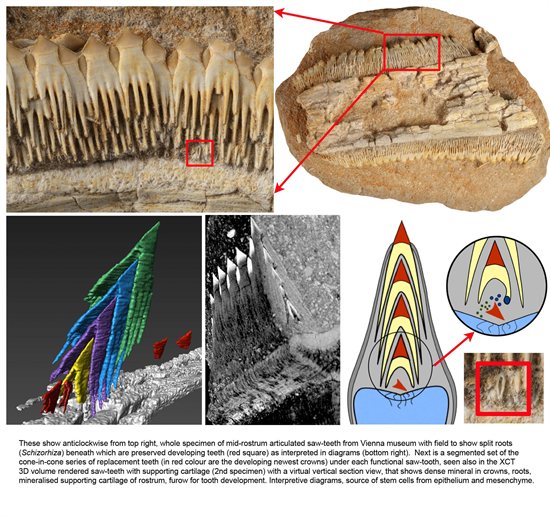Piercing teeth in vertebrates didn't evolve from their scales
A study led by scientists at King’s College London, the Natural History Museum, Birbeck, University of London, University of Sheffield and the University of Vienna has questioned one of the most important theories in vertebrate history; that the formidable array of teeth in the mouth, for example, in sharks, evolved from their external skin scales. The research has been published today in the Proceedings of Royal Society B and is sponsored by Natural Environmental Research Council (NERC).
The scientists, including Dental Institute Professor Moya Meredith Smith, used X-ray computed tomography at state-of-the-art imaging and analysis labs at the Natural History Museum, London and the Department of Anthropology, Vienna, to closely examine remains of the fossil ray, Schizorhiza stromeri, which has a near identical dentition to sharks and rays, and also an extended cartilaginous rostrum, like saw fish today. The exquisite detail identified clear differences between the organization and replacement of the animal’s tooth-like external scales along its saw-rostrum and teeth structure.
This contradicts classical theories that suggested teeth in vertebrates directly evolved from external skin scales. These new fossils from the Cretaceous of Morocco identified important differences between the anatomy, organization and replacement of saw-teeth and oral teeth, suggesting teeth and scales had independent evolutionary histories.
‘The data generated from the X-ray computed tomography has provided us with an exceptional insight into the evolution and adaptation of the teeth of some of the most fearsome creatures on Earth. The ‘saw-teeth’ of Schizorhiza stromeri, despite being from a Cretaceous-aged fossil, preserved essential development detail and showed an unusual series of rotations before they became functional, very different from the development of typical teeth in the mouth. These differences contradict classical theories of tooth evolution; saw-teeth are simply modified external scales. However, they do show the extreme plasticity of the developmental unit of the skin denticle to be able to make such diverse structures as this rostrum saw-teeth.
The scales and teeth on sharks and rays are a striking and distinctive feature, but we know surprisingly little about their evolution and adaptation: particularly the differences between species. We can now use these methods to research a range of fossil and living vertebrates and find out more about the evolution and diversity of the teeth on some of the most dangerous creatures on our planet’.
